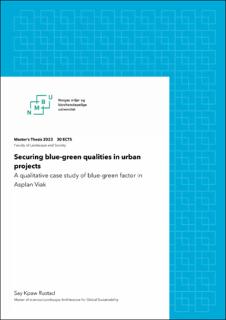| dc.description.abstract | As the urban populations continue to grow and the demand for housing, commercial and public spaces rise, the competition for limited available spaces is becoming more intense. This has led to an increased pressure on urban planners and policymakers to find innovative solutions to accommodate the needs of all residents and businesses in these areas. Due to climate change, we can expect more frequent and intense rainfall, combined with more dense surfaces in cities, which creates a need for nature-based solutions for stormwater management and green areas.
Landscape architects can use the blue-green factor (BGF) method as a tool to improve and facilitate the incorporation of Blue-Green Infrastructure (BGI) in the designs, ensuring that the environmental benefits are maximized and contributing to a more sustainable and resilient urban environment.
The blue-green factor calculation method has been used in Norway for nearly a decade and is increasingly being adopted by several Norwegian municipalities. However, there are still uncertainties regarding the method, especially related to the practical implementation. This thesis aims to contribute to the current understanding of the strengths and weaknesses associated with BGF in relation to stormwater management and biodiversity. Additionally, the thesis seeks to explore improvements for BGF, that can better facilitate for stormwater management and biodiversity conservation.
This thesis aims to highlight some of the strengths and weaknesses with BGF. To achieve this, Asplan Viak, has been selected as the case company for the thesis. Asplan Viak is a large and recognized actor in Norway- and has great experience in using the Norwegian BGF method in their projects.
The empirical data has been collected through a qualitative study, through pre-structured in-depth interviews. The method has provided insight into the strengths and weaknesses related to the use of the Norwegian BGF-method, through Asplan Viak`s experiences. The empirical evidence shows that BGF is effective in promoting the inclusion of trees and vegetation in landscape projects, but it is not as effective in managing stormwater beyond the first step of the three-step strategy to capture and infiltrate runoff from smaller rain events. The study also identifies improvements for BGF, that can better facilitate for stormwater management and biodiversity conservation. The results of this study provide insight into the practical implementation of BGF and contribute to the ongoing discussion surrounding its use in landscape architecture and urban planning. | |
